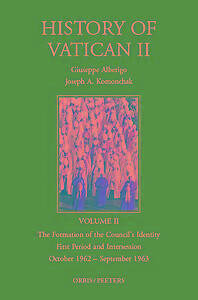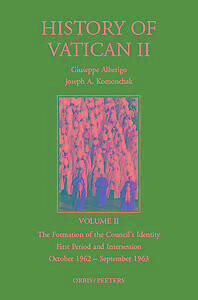
Je cadeautjes zeker op tijd in huis hebben voor de feestdagen? Kom langs in onze winkels en vind het perfecte geschenk!
- Afhalen na 1 uur in een winkel met voorraad
- Gratis thuislevering in België vanaf € 30
- Ruim aanbod met 7 miljoen producten
Je cadeautjes zeker op tijd in huis hebben voor de feestdagen? Kom langs in onze winkels en vind het perfecte geschenk!
- Afhalen na 1 uur in een winkel met voorraad
- Gratis thuislevering in België vanaf € 30
- Ruim aanbod met 7 miljoen producten
Zoeken
History of Vatican II, Vol. II. the Formation of the Council's Identity. First Period and Intersession. October 1962 - September 1963
English Version Edited by J.A. Komonchak
Giuseppe Alberigo
€ 117,95
+ 235 punten
Omschrijving
This second volume of The History of Vatican II describes the dramatic first session of the Council as it was electrified by Pope John XXIII's inspiring and liberating speech. It tells the story of how the bishops repudiated the doctrinal texts they had been expected to rubber stamp and gave overwhelming approval of the call to reform the church. Volume II describes the main protagonists, the issues at stake in the debates, and the gradual emergence and triumph of the desire for spiritual renewal and pastoral reform. It concludes with a study of the Council's agenda, an agenda that permitted this desire to become effective in subsequent sessions. In the pages of The Formation of the Council's Identity, such important ecclesiastical personages as the Cardinals Siri of Genoa and Suenens - virtual polar opposites on questions of aggiornamento - and soon-to-be famous periti such as Ives Congar, Hans Kung, and Karl Rahner make their appearances. The mood of the conservatives was one of trepidation in the face of unknown possibilites; the mood of the progressives a mixture of gloom and apprehension in the face of reactionary legalistic preparatory documents and commissions. In the midst of such contradictory expectations, John XXIII injected something completely unexpected in his "moonlight address" on the evening the Council opened. His deep humanity impressed itself upon the Council delegates and the world at large. Chapters include a preface by G. Alberigo; (1) "The Dramatic Opening Days" by A. Ricardi; (2) "The Council Gets Underway" by G.P. Fogarty; (3) "The Debate on the Liturgy" by M. Lamberigts; (4) "A Portrait of the Assembly" by H. Raguer; (5) "The Clash over Divine Revelation" by G. Ruggieri; (6) "The Brief Debate on Communications Media" by M. Lamberigts; (7) "Beyond an Ecclesiology of Polemics; The Debate on the Church" by G. Ruggieri; (8) "The Second Preparation of the Council during the Intersession" by J. Grootaers; (9) "Ebb and Flow: Conciliar Dynamics during the Intersession" by J. Grootaers; and (10) "The Conciliar Experience" by G. Alberigo.
Specificaties
Betrokkenen
- Auteur(s):
- Uitgeverij:
Inhoud
- Aantal bladzijden:
- 605
- Taal:
- Engels
- Reeks:
Eigenschappen
- Productcode (EAN):
- 9789068319729
- Verschijningsdatum:
- 1/01/1997
- Uitvoering:
- Hardcover
- Formaat:
- Genaaid
- Afmetingen:
- 165 mm x 246 mm
- Gewicht:
- 1133 g

Alleen bij Standaard Boekhandel
+ 235 punten op je klantenkaart van Standaard Boekhandel
Beoordelingen
We publiceren alleen reviews die voldoen aan de voorwaarden voor reviews. Bekijk onze voorwaarden voor reviews.









